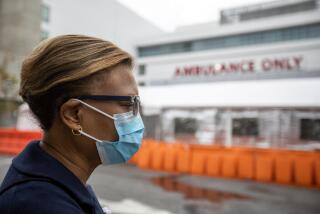Simi Hospital Adapts to New Times : Health care: With traditional sources of revenue declining, the facility is increasing focus on outpatient services.
- Share via
Chafing under the double burden of declining revenues and heavy debt, officials at Simi Valley Hospital and Health Care Services say they are re-examining the way they deliver care to patients.
In the first half of 1992, the medical center ran a deficit of $1.67 million out of an operating budget of $26.37 million.
Hospital officials cite the cost of acquisitions and steadily decreasing revenues due to an increase in managed-care-plan patients as reasons for the financial problems of the medical center, which is owned by Adventist Health System/West.
The struggle facing Simi Valley Hospital is one health-care facilities around the country must deal with as revenues stem less and less from traditional, so-called indemnity insurance plans and more from managed-care organizations.
Traditional insurance plans allow patients to choose their own provider, be it a doctor or a hospital, and the health-care providers are reimbursed for the cost of the care they provided.
Managed-care organizations, however, strike deals with health-care providers, agreeing to pay a limited amount for any given procedure or type of care. Typically, a hospital or doctor will make less money treating a patient on a managed health-care plan than one covered by more traditional insurance plans.
In 1988, indemnity insurance plans accounted for 25% to 30% of the hospital’s revenue sources, said Tim Patten, the hospital’s chief accounting officer. Today, he said, they make up less than 10%, with much of the difference made up by lower-paying, managed-care plans.
Hospitals are also tending to treat a dwindling patient population. In a recession, health-care professionals have found that people go to their doctor less often--especially when, as with many health plans, they are shouldering all or a large portion of the costs.
The combination has hit Simi Valley Hospital hard, complicating the debt officials knew they would incur when, in 1987, they merged with Mountain View Medical Center across town--unknowingly acquiring leaky fuel tanks, which have cost more than $3 million to repair. The hospital incurred additional costs in January, 1992, when it bought Aspen Outpatient Center.
“One of the things we’ve been going through is the restructuring of the health-care delivery in this community,” said Alan Rice, the president of the hospital. “So we’ve assumed some financial struggles. These are expenses that are not routine and ongoing, but transitional.”
As part of an effort to evolve with the changing medical geography, hospital officials are pouring more resources into their auxiliary, non-acute care services, such as home health care and the Aspen Outpatient Center.
In the first half of 1993, the hospital’s inpatient volume has remained flat, Patten said. But outpatient service volume jumped 14%, with home health-care volume alone increasing by 20% to 30%. Much of the institution’s non-hospital services are geared toward care that prevents future medical problems, rather than fixing health troubles after they occur, hospital officials say.
“In the future, you will see hospitals go more toward primary (and outpatient) care,” said Dr. Art Kaplan, a bioethics professor at the University of Minnesota and a member of the White House Health Care Task Force. “It’s clear that many people think we can save money by more preventive care.”
In a further effort to lower costs, the hospital brought in a consulting team last fall to pinpoint waste in the organization and propose new methods of operating. As a result of changes already implemented, Patten said, the hospital cut $250,000 out of a $7-million supply budget.
One example of cost cutting, he said, is the hospital’s paper towels. Administrators found that they could save $6,000 buying recycled paper towels rather than the ones bleached white. Another $7,000 was saved when the cardiology unit began buying its bandage, gauze and alcohol wipes for blood tests in their component parts, instead of purchasing the three together in more expensive, prepackaged kits, he said.
More to Read
Sign up for Essential California
The most important California stories and recommendations in your inbox every morning.
You may occasionally receive promotional content from the Los Angeles Times.













